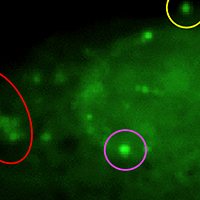 Smart Citations
Smart CitationsSee how this article has been cited at scite.ai
scite shows how a scientific paper has been cited by providing the context of the citation, a classification describing whether it supports, mentions, or contrasts the cited claim, and a label indicating in which section the citation was made.
Alcian blue staining to track the intracellular fate of hyaluronic-acid-based nanoparticles at transmission electron microscopy
The main step in the assessment of nanomaterial safety and suitability for biomedical use is the location and the dynamic tracking of nanoparticles (NPs) inside cells or tissues. To precisely investigate the uptake mechanisms and intracellular fate of NPs, transmission electron microscopy is the technique of choice; however, the detection of NPs may sometimes be problematic. In fact, while NPs containing strongly electron dense (e.g., metal) components do not require specific detection methods at the ultrastructural level, organic NPs are hardly detectable in the intracellular environment due to their intrinsic moderate electron density. In this study, the critical-electrolyte-concentration Alcian Blue method set up by Schofield et al. in 1975 was applied to track hyaluronic-acid-based NPs in muscle cells in vitro. This long-established histochemical method proved to be a powerful tool allowing to identify not only whole NPs while entering cells and moving into the cytoplasm, but also their remnants following lysosomal degradation and extrusion.
Downloads
Publication Facts
Reviewer profiles N/A
Author statements
- Academic society
- N/A
- Publisher
- PAGEPress Publications, Pavia, Italy
How to Cite
PAGEPress has chosen to apply the Creative Commons Attribution NonCommercial 4.0 International License (CC BY-NC 4.0) to all manuscripts to be published.

 https://doi.org/10.4081/ejh.2019.3086
https://doi.org/10.4081/ejh.2019.3086






